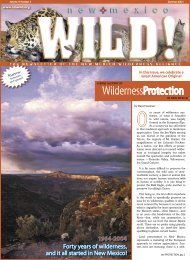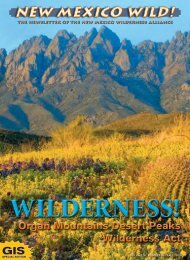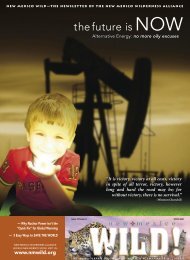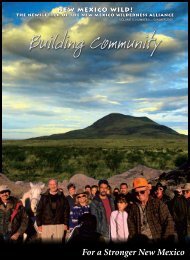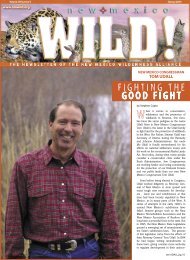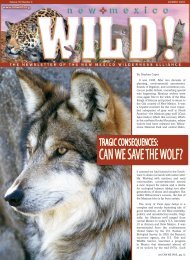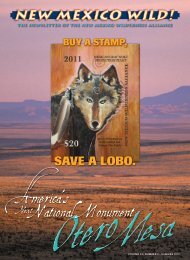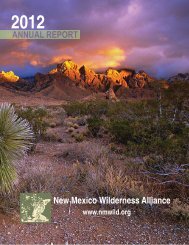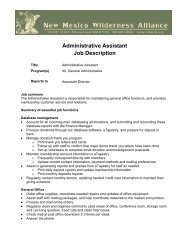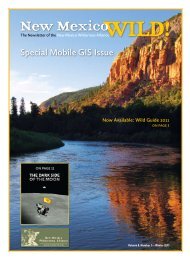Otero Mesa Update - New Mexico Wilderness Alliance
Otero Mesa Update - New Mexico Wilderness Alliance
Otero Mesa Update - New Mexico Wilderness Alliance
You also want an ePaper? Increase the reach of your titles
YUMPU automatically turns print PDFs into web optimized ePapers that Google loves.
www.nmwild.org
NEW MEXICOWILDERNESSALLIANCEMain Office505/843-8696 • fax 505/843-8697nmwa@nmwild.org • www.nmwild.orgP.O. Box 25464Albuquerque, NM 87125202 Central Avenue, SE • Suite 101Albuquerque, NM 87102Las Cruces Field Office275 N. Downtown MallLas Cruces, NM 88001505/527-9962Mission StatementThe <strong>New</strong> <strong>Mexico</strong> <strong>Wilderness</strong> <strong>Alliance</strong> is dedicatedto the protection, restoration, and continuedenjoyment of <strong>New</strong> <strong>Mexico</strong>’s wild lands and<strong>Wilderness</strong> areas.NMWA StaffLas Cruces OfficeGreta Balderrama, Grassroots OrganizerAlbuquerque OfficeTisha Broska, Membership CoordinatorSteve Capra, Associate DirectorNathan <strong>New</strong>comer, Grassroots OrganizerRoxanne Pacheco, Finance ManagerJim Scarantino, Executive DirectorMichael Scialdone, Director of <strong>Wilderness</strong> ProtectionBoard of DirectorsDave Parsons, Chair, Albuquerque, NMTom Mouck, Treasurer, Albuquerque, NMNancy Morton, Secretary, Albuquerque, NMPam Eaton, Denver, CODave Foreman, Albuquerque, NMRandall Gray, Lake Valley, NMBob Howard, Santa Fe, NMWes Leonard, El Paso, TXKathy Love, Albuquerque, NMDavid Mielke, Placitas, NMMelissa Savage, Santa Fe, NMTodd Schulke, Silver City, NMBob Tafanelli, Las Cruces, NMSteve West, Carlsbad, NMTom Wootten, Cortaro, AZ<strong>New</strong>sletter StaffTisha Broska, Managing EditorJoe Adair, Design EditorJim Scarantino, Contributing EditorJames Broska, Copy EditorThe ArtistsCover photo by T. Broska; p. 3 tree artwork by A.Ahlander, tree hugger cartoon by B. Maguire, bearphoto by K. Ward; p. 4 photo by R. Watt; p. 5 photos byG. Balderrama; p. 6 photo by S. Capra; p. 8 photo of Jackby S. Capra and photo of Jack and Ed by C. Loeffler; p.9 photo by S. Capra; p. 10 photos by M. Heinrich; p. 11painting by M. Morrison; p. 12 photo by S. Capra; p. 13photo of Elsie Mackinnon courtesy of Laughing Lizard,Rosemary Cascio photo courtesy of The Herb Stop; p.14 photo courtesy of John Toppenberg (1996); p. 16graphic by J. Adair; p. 17 photo by T. Broska; p. 18 photoby N. <strong>New</strong>comer, graphic by J. Adair and illustration byE. Cantor<strong>Wilderness</strong>The <strong>Wilderness</strong> Act of 1964 established theNational <strong>Wilderness</strong> Preservation System to preservethe last remaining wild lands in America. The<strong>Wilderness</strong> Act, as federal policy, secures “an enduringresource of wilderness” for the people. <strong>Wilderness</strong>is defined as an area that has primarily beenaffected by the forces of nature with the imprint ofhumans substantially unnoticeable.It is an area that offers outstanding opportunityfor solitude or a primitive or unconfined type ofrecreation, and an area that contains ecological,geological, or other features of scientific, educational,scenic, or historical value.Thank you, WILD OATS, for your support!<strong>New</strong> <strong>Mexico</strong> WILD! is available at allWILD OATS stores in Albuquerque.YO! What’s with theSpotted Kitty?Since we went with our new masthead,we have received many inquiries aboutthe big, wild cat gracing the left-handcorner of our front page:“Why do you have an African animal foryour mascot?”“We don’t have cheetahs in <strong>New</strong> <strong>Mexico</strong>.Who are you trying to kid?”“I hope that big cat eats all you wackogreenies”And our personal fave: “Yo! What’s with thespotted kitty?”Well, that “spotted kitty” is a jaguar.Panthera onca. El tigre del Norte.And not an African import, but a native<strong>New</strong> Mexican. Jaguars have been in <strong>New</strong><strong>Mexico</strong> so long they probably know whathappened at Chaco Canyon.Jaguars once ranged far north into <strong>New</strong><strong>Mexico</strong>, and beyond into southern Coloradoand Utah. In 1997, a large jaguar wasphotographed south of Lordsburg in thePeloncillos. Those mountains don’t get theirreputation as a critical wildlife corridor forAfrican Import?Native <strong>New</strong> Mexican!nothing. In 1998, a black jaguar—passingthrough what is called its melanistic phase—was recorded in a credible sighting in theBlack Range, west of Truth or Consequences.Other magical creatures have followed thesame Peloncillos by-way from tropical <strong>Mexico</strong>,and the Sierras Madres, into the Land ofEnchantment. Coatamundis — think of araccoon crossed with a spider monkey — havereturned to the Gila Country. This year abroad-billed parrot vacationed at Ted Turner’sArmendaris Ranch east of Elephant Butte.Tree Huggers 3Columbine-Hondo, Rocky Mountain Jewel 4Love <strong>Wilderness</strong> and Lose Weight 5Take a Hike 5<strong>Otero</strong> <strong>Mesa</strong> Fight is at its Hottest Point Yet 6Letters to NMWA 7A Conversation with Jack Loeffler 8Mardy Murie 9Ojito <strong>Wilderness</strong> Act 10Ojito, Seeds of Inspiration 11Coalition <strong>Update</strong> 11The Fight is Still on for <strong>Otero</strong> <strong>Mesa</strong> 12Panthera OncaParrots once were found in large numbersin southern <strong>New</strong> <strong>Mexico</strong>, until meat huntersworking for mining companies wiped them out.<strong>Wilderness</strong> is the key tothese royalty of Creationreclaiming their place in ourState’s landscape. <strong>Wilderness</strong>saves for them and for usimportant remnants offreedom and grandeur. Without <strong>Wilderness</strong>,<strong>New</strong> <strong>Mexico</strong> could be, well, way too much likeTexas. It certainly wouldn’t be the home welove with such fierce passion.We hadn’t intended it when we set out tojazz up our look, but come to think of it, nobetter mascot than the jaguar could be chosento represent <strong>New</strong> <strong>Mexico</strong> Wild!So, dude, that’s what’s with the spotted kitty.Thanks for asking.Laughing Lizard 13Ruidoso’s Herb Stop 13Mexican Gray Wolves Struggle 14Patriots Love Trees 15Joyce Kilmer: Poet, Tree Lover, Hero 15Bully! 16Wildlands Painted! Art Show A Big Hit 17Beauty of Nature 17Young Voices 18Nancy Morton: A Lifetime of Caring 19Upcoming Hikes 20
Letter To N WAedited by Joe AdairsMOUR FAVORITE LETTER:SCORPIONDAMNATION!Having read the info onyour web site I now knowwhat an environmentalwacko really is. To hellwith the scorpions andsnakes and whateverother wildlife is there.We need gas at reasonableprices.Doris AndreDoris, while yourassessment of us isessentially true, gas pricesare a product of the cost ofimported oil, not domestic.Even if we managed towipe out every livingcreature in the state withnew oil wells, you wouldn’tpay less for gas. If youwant to save gas money,drive a fuel efficient car.-NMWA--------------------------------REGULAR FOLKAPPRECIATEDHi -I read a copy of yournewspaper while visitingthe Zele Cafe in Santa Fe.It was very compelling.I especially appreciatedthe articles written byranchers who have hadtheir lives impacted bygas drilling. And a homeowner outstanding in hisfield, (ha). It’s much moresignificant to read thefirst hand experiences ofthe locals, rather than aone sided article from anenvironmentalist.I tore out the “Please JoinUs” box so I could send youa donation.Best wishes -Robert Marcos,photographerThank you, Robert! Justgoes to show that notall the people that careabout the environment areextremist wackos like us.-NMWA--------------------------------WILDERNESS IS A BLAST!Dear NMWA-I am still telling everyoneI see about our trip to<strong>Otero</strong> <strong>Mesa</strong> lastweekend. Rich and I hadsuch a great timewith you all, andwere amazedat all the animalswe saw. As we wereleaving at dusk, wesaw severalherds of whitetailedmule deer,and a herd of 7Oryx. I forgot to tellyou that while wewere walking outaround the prairiedog towns that Isaw a large jackrabbit. I startledhim and he ran pastme. So cool … I hopewe’ll see you againsoon. Thanks againfor a great learningexperience.Sincerely,Gail KellyWe were glad to have you,Gail! Everyone should joinour sponsored hikes in<strong>New</strong> <strong>Mexico</strong>’s WILDlands.See Page 20 for upcomingevents. -NMWA--------------------------------NOT NICE FOLKPeople that will ruin theearth so they can make afew thousand dollars arethe worst criminals.Sali DaltonSanta Fe, NMSali, you and Doris shouldhave a little talk. -NMWA<strong>New</strong> <strong>Mexico</strong> WILD!--------------------------------WILDERNESS ISFOR PEOPLE!I do not want to be amember of N.M. Wild.<strong>Alliance</strong>. People have theright to use our publicland. I think your goal isto keep people out so theanimals and etc. can haveit. You are putting themover humans.I don’t think you shouldhave complete control“TO HELLWITH THESCORPIONS ANDSNAKES ANDWHATEVEROTHERWILDLIFE ISTHERE. WENEED GAS ATREASONABLEPRICES.”over public land. Itsnot your right to do so.Farmers and Ranchers donot need Mex. Gray wolvesto kill their cattle.I think this whole thing isa bunch of boloney and thenext idea will be to takeprivate land from peoplethat has worked and paidfor it.-ANONYMOUSThere’s several misconceptionswe need to clearup here, Anonymous. Ouronly goal is to preserve<strong>New</strong> <strong>Mexico</strong>’s wild placesfor the people, not to keepit from the people. Wewant our children and ourchildren’s children to enjoythe same <strong>New</strong> <strong>Mexico</strong>you have. Ranchers aresometimes our best alliesin this struggle. Theywant the land kept free ofoil and gas wells, too. If aMexican Gray Wolf shouldhappen to harvest a Heifer,the ranchers are reimbursedat market rate forthe lost little doggie(s). Wedon’t want control of theland wrested from the people,we ensure it remainsin the control of the people—and not the oil and gascompanies. Are you sureyou don’t want to join us?-NMWA-------------------------------NOT WORTH THE WAITNMWA-Sorry, I’ve stoppeddonating to environmentalcauses until afterthe warmongeringtotalitarians inWashington DC are votedout of power.Dale L. BerryGrants, NMDale, in a political climatelike this, we need you nowmore than ever! Whenthe voices of conservationare drowned out by socalled“conservatives,”(Teddy Roosevelt is rollingover in his grave,) itbecomes more vital thanever that our message beheard. Sweeping changeshave already been madethat benefit no one butprofiteers. Those changeswill take years of effort toreverse... just to return usto where we were beforethe Bush Regime tookpower. - NMWALove NMWA? Hate us? Love nature, butcan’t stand conservationists? We want tohear from you! Drop us a note today:email - nmwa@nmwild.org orNMWA, PO Box 25464Albuquerque, NM 87125-0464Page 7
Iremember sitting atthe Albuquerque airporttrying to have aconversation with JackLoeffler. We didn’t getvery far. Every two minutes we wereinterrupted by someone who knewJack. It seemed Jack was acquaintedwith everyone in the teeming airport.Jack has been a fixture in <strong>New</strong> <strong>Mexico</strong>for over 40 years. He is a writer, radiodocumentary producer, musician (jazztrumpet and baroque recorders), adventurer,ethnographer, and was Ed Abbey’scompañero and partner in deviltry andmischief. Jack read more than a few ofAbbey’s works before a publisher tookthem. Abbey gave Jack his type-writtenmanuscript of “The Monkey WrenchGang.” We recently sat down again, thistime at Castro’s Restaurante in SantaFe. We were interrupted only a halfdozen times. Everyone, say hello to JackLoeffler.—Jim Scarantinopeople&wildernessYou are almost a living legendfor your experiences with indigaConversation withJack Loeffler,Ed Abbey’s CompañeroBy Jim ScarantinoLet’s start this like we’re sharinga secret handshake. I carry withme every day powerful memoriesof wilderness experiences. Howabout you?I’m a hunter-gatherer. I hunt downsounds and gather them with microphonesand recorders. Once when Iwas camped in the Kuakatch Washin the Sonoran, I had something ofan epiphany. I had set out a pair ofmicrophones in a stereo configuration.I’d cranked up the gain so that I washearing around six hundred percentbetter than humans normally hear. Iheard different species of birds soundingalarm signals from south to norththrough my field of hearing. I got outmy binoculars and spotted a low flyinghawk about a mile away heading north.This experience greatly affected me. Iwas the only human around for miles.That experience was an aural glimpseinto the workings of the biotic communitythat has evolved there since the endof the Pleistocene. For a time, I left myown language behind and was celebratingin wilderness lingo.You probably have far more wildernessstories to tell than most ofus. What have you learned fromyour years pushing into the remainingwild lands of North America?We are rooted in Nature. We are amember species of the Animal Kingdom.And while we have developed thetechnology to considerably re-shape ourrespective habitats in accordance withour cultural fantasies, we as a speciesstill rely upon wilderness forsurvival.Indeed wilderness is hometo our gene pool, that sacredelixir that has fomented lifeinto consciousness. We areconnected to the wild, asthrough an umbilical cord,by the double helix at the coreof our being. And we mustrely upon the geography ofthe wild to provide the coordinateswith which to plot atrue azimuth back home tobalance and sanity. We arepresently coursing through ameander that we’d best abandon.Otherwise, we’ll be trapped inan eddy at the heart of an erroneousparadigm founded on turning Paradiseinto money.You have just related <strong>Wilderness</strong>to mankind, or the other wayaround. And you have defined,at least in part, <strong>Wilderness</strong> as abenefit to people.No matter where you wanderin desert country, you find humanspoor that may go back a thousandyears. Long ago, a friend and I werepoking around in the Plains of SanAugustine. We’d camped near BatCave, a place continuously inhabitedby humans for several thousand years.There was evidence of corn, as well asmany bone fragments in the midden.I found a perfect arrowhead made bysomeone whose personal moleculeshad long since been scattered throughoutthe habitat. Here was evidence ofa human community inhabiting wilderness,being part of wilderness, thepeople themselves wild in a way thatwas commensurate with the Spirit ofPlace. Their purview included farmore than I could imagine, just asmine would have been utterly aliento them.That would go without saying…Another time Iwas camping witha friend, but hikingsolo in a beautifulside canyon in theChinle Wash watershed.I had left thetrail, and whiletraipsing throughthe red rock wilderness,I found ahuman jawbone. Ipicked it up, examinedit and discoveredthat it wasstill fresh, onlyrecently de-fleshed.I had heard that anacquaintance whohad lived in the areahad disappearedwithin the last“We areconnected tothe wild, as throughan umbilical cord,by the double helixat the core ofour being.”year. Could this be what remained?That night curled up in my sleepingbag, the only light remaining cast bythe stars, I seemed to sense the presenceof chindi’i, or ghosts of departedathabascans and ancestral puebloanswhose lives had preceded my own inthis wilderness canyon country.Great story, but what…Patience. Yet another time, whilerunning part of the Green River, afriend and I hiked a side canyon andfound a skeletal human forearm protrudingfrom beneath a fallen boulder.Could this be where EverettReuss zagged instead of zigged? Somefellow human had met his fate wanderingthis remote wilderness.To me, one condition that characterizeswilderness is that a singlehuman is one on one with the restof the bioregion. One may not be atthe top of the food chain. One mustdance within the play of the elements.One must harmonize with the flowof Nature. And if one is lucky, one’sintuitions will burst with recognitionof the genesis of our species within ourwilderness homeland and know thatwe would be bereft without the wild.Page 8 Winter 2003
enous peoples. With regard towilderness, what have those experiencestaught you?I have spent a lot of my adult lifein communities of indigenous peoplethroughout the American Westand <strong>Mexico</strong>. I’ve recordedtheir songs and their storiesand reflected on the enormousdegree to which culturesare shaped by their respectivehabitats. I’ve wandered amongthe Nez Perce, Shoshonean,Ute, Navajo, Hopi, Rio GrandePuebloan, Apache, Tohono andHiacite O’odham, Yaqui, Seri,Tarajumara, Huichol, andMayan communities, and ineach case met men and womenwhose wisdom is founded onunderstanding mankind’s placein wilderness. They are guidedby the Spirit of Nature, by thelocal deity whose numen is everapparent to those whose sensibilitieshave not been atrophiedby technofantasy or life in themegalopolis.One time I was with a group of Serifisher folk in a boat in the wildernesswaters of the Sea of Cortez. There’s adangerous stretch between Isla TiburonMardy Murie, Heart and Soulof the Modern <strong>Wilderness</strong>Movement, Has Died at 101by Stephen CapraHaving lived a life full of adventureand accomplishment, MardyMurie died peacefully on October19, 2003 in her cabin on the MurieRanch in Moose, Wyoming. Muriehad a passion for wild places thatshe expressed vividly in her writings,her speeches and her testimonyat public hearings. Herintense personal resolve to protectwilderness, stood in contrast to herwarm and welcoming personality,that drew an unending stream ofvisitors to her home. From conservationiststo scientists, from Presidentsto schoolchildren, the doorwas always open and the chance tolearn and be inspired almost routine.Mardy Murie was born in Seattlein 1902, but raised in the frontiertown of Fairbanks, Alaska. Atan early age she learned how todeal with harsh winters and roughliving while developing a love forthe wild country beyond her doorstep.Shortly after becoming thefirst woman graduate of the Universityof Alaska, she met a youngbiologist, Olaus Murie, who wasstudying caribou for the U.S. Fishand Wildlife Service. Their lifetogether was marked by wildernessadventure in northern Alaska andthe Jackson Hole area and includedtaking their children with theminto some of the most remote andwild country in America.In 1956, Mardy traveled to theupper Sheenjek River on the southslope of the Brooks Range. It wasthis summer-long adventure thatbegan the campaign to protect theArctic National Wildlife Refuge.Mardy chronicles the tripin the later chapters of Twoin the Far North, one of theclassic books dealing withthe environment.When the <strong>Wilderness</strong> Billwas passed in 1964, it wasMardy Murie that stoodbeside President Johnson asthe Bill was signed.For me personally, MardyMurie was something special,perhaps a link to atime when environmentalistsfought from the heart.Before focus groups, neoconservativesand polling.She was also one of the lastand Isla San Estevan where whirlpoolsand riptides can launch you to your fatein a moment. I was recording a songcycle wherein each song is sung fromwithin a trance before physically enteringa specific danger zone. The songsenable the fisher people to align theirmythic co-ordinates with their immediatehabitats and venture through withsome margin of safety.Our species in indigenous to wilderness.Over the five hundred or so generationsthat separate us from our Pleistoceneancestors with whom we share ourgenome, we’ve frequently followed culturalpaths that have led us away fromwilderness and “the practice of thewild.” Our biotic community requires alarge measure of wilderness to continuethe great bio-experiment on our planet.We as individuals within our speciesrequire wilderness in which to quietlyenter and renew those sensitivities necessaryfor sanity.You always seem cheerful andoptimistic, even in the face ofof a special class; her peers wereAldo Leopold, Bob Marshall andSig Olsen.Reading Two in the Far North,inspired me to adventure and mademe think long and hard about thevalue of wild, unspoiled places. In1990, when I began to walk from<strong>Mexico</strong> to Canada along the ContinentalDivide, I did so to raiseawareness for the Arctic NationalWildlife Refuge. Before leaving, Iwrote Mardy Murie and explainedmy plans. In early August that yearI had made my way north to JacksonHole. On a Friday evening Igave a talk to about 100 peoplein Jackson about protecting theArctic National Wildlife Refuge. Inthe crowd was Mardy Murie, alongceaseless, irreparable loss of wildlands that mean so much. How doyou do it?The great human experiment isindeed a splendid adventure. My oldcompañero Ed Abbey regarded thehere-and-now as a great time to be alivebecause there’s so much to laugh aboutand be interested in. Music, art, literature,science and knowledge in generalprevail in abundance. The downsideof the human bio-moment includesour vast over-population, a now endangeredinter-linked cultural and biologicaldiversity, an ever more limited cognitivediversity, and a deadly trail ofmisapplication of science and technology.It is a great privilege, while thewild still exists, to step out of the presentmilieu of civilization, head into wildernesswith knife, stave and lore …andgo feral.Jack, the privilege has been mine…ours. Thanks, hombre.with her sister in law and two ofher now grown children. After mytalk she spent some time with me,sharing insights, telling stories oftimes past and encouraging a tired,but idealistic young man to keepspeaking out and defending thosewild places that she spent her lifeworking so hard to protect.Perhaps the greatest tribute to thelife of Mardy Murie, would be thecreation of the Mardy Murie <strong>Wilderness</strong>,on the coastal plane of theArctic National Wildlife Refuge.Luckily there remain a few millionpeople, determined to makeit a reality.For more information, contact theMurie Center: www.muriecenter.org<strong>New</strong> <strong>Mexico</strong> WILD!Page 9
Ojito <strong>Wilderness</strong> Actland ethic 40 years later.By Martin HeinrichOn September 24, SenatorJeff Bingaman and Rep.Tom Udall introducedthe Ojito <strong>Wilderness</strong>Act (S. 1649/H.R. 3176), which wouldpermanently protectthe approximately11,000-acre Ojito <strong>Wilderness</strong>northwest ofAlbuquerque. The billis co-sponsored by Sen.Pete Domenici and Rep.Heather Wilson. Ifapproved, the measurewould create the firstnew <strong>Wilderness</strong> area in<strong>New</strong> <strong>Mexico</strong> since 1987.The legislation allowsthe Pueblo of Zia topurchase abutting BLMland--land which holdsstrong cultural and religioussignificance forthe people of Zia. Lands purchasedby the Pueblo of Zia will remain opento the public and will be managed asopen space in perpetuity. This landwill be protected from development,off road vehicle damage, mining andoil and gas exploration.This historic bill would not havecome about were it not for the strongpartnership forged between NMWA,the Coalition for <strong>New</strong> <strong>Mexico</strong> <strong>Wilderness</strong>,the Pueblo of Zia, The <strong>Wilderness</strong>Society, numerous businesses,conservation organizations and manylocal and statewide elected officials.Thanks to all of you who worked hardto make this bill a reality.Statement of Senator Jeff Bingaman,in the U.S. Senate, September24, 2003:“I am particularly pleased tointroduce this legislation in celebrationof the 40th anniversary of The...offering a spectacularand unique opportunityto view from a singlelocation the juxtapositionof the southwesternmargin of the RockyMountains, the ColoradoPlateau, and the RioGrande Rift...-Sen. Jeff Bingaman<strong>Wilderness</strong> Act of 1964 andthe eightieth anniversary ofthe Nation’s first administratively-designatedwilderness.This celebration is particularlymeaningful to myState of <strong>New</strong> <strong>Mexico</strong>, for itis both the proud birthplaceof wilderness and the hometo two of its fathers: AldoLeopold, who worked fromAlbuquerque for 15 years tocreate in 1924 the Gila wildernessnear my home insouthern <strong>New</strong> <strong>Mexico</strong>, and<strong>New</strong> <strong>Mexico</strong> Senator ClintonAnderson, who wasinstrumental in codifyingAldo Leopold’s wilderness“Forty years later still, theOjito provides a unique wildernessarea that is important notonly to its local stewards, butalso to the nearby residents ofAlbuquerque and Santa Fe…It is an outdoor geology laboratory,offering a spectacularand unique opportunityto view from a single locationthe juxtaposition of the southwesternmargin of the RockyMountains, the Colorado Plateau,and the Rio Grande Rift,along with the volcanic necksof the Rio Puerco Fault. Itsrugged terrain offers a rewardingchallenge to hikers, backpackers,and photographers. It sheltersancient Puebloan ruins and anendemic endangered plant, solitudeand inspiration.The words of Leopold and SenatorAnderson are fitting for the Ojito,for it is ‘what the land was, what itis and what it ought to be’; let the‘Ojito <strong>Wilderness</strong> Act’ be ‘a demonstrationby our people that we canput aside a portion of this which wehave as a tribute to the Maker andsay this we will leave as we foundit.’”Please thank our Senators and Representativefor introducing the Ojito<strong>Wilderness</strong> Act.CONTACT YOURSENATOR ANDCONGRESSPERSONTODAYAND SHOW YOURSUPPORT FOR OJITORep. Tom Udall1414 Longworth House Office Bldg.Washington, DC 20515Fax: 202-226-1331 or 505-986-5047Rep. Heather Wilson318 Cannon House Office Bldg.Washington, DC 20515Fax: 202-225-4975 or 505-346-6723Senator Jeff Bingaman703 Hart Senate Office Bldg.Washington, DC 20510Fax: 202-224-2852 or 505-346-6780Senator Pete Domenici328 Hart Senate Office Bldg.Washington, DC 20510Fax: 202-228-0900 or 505-346-6720REMEMBER,YOUR VOICECOUNTS!Page 10 Winter 2003
Introduced in CongressOjito, Seeds ofInspirationBy Melinda Morrison, Colorado ArtistBeing an artist, my love affair for Ojito startedwith great ambivalence. I saw Ojito for thefirst time in deep winter last February. Thevast, harsh environment seemed to leap outand shout “ go away!”It was as if there wasan unsaid tale in theair, a tale that spokeof sacred places wherepossibly few had survivedto tell the story.Overwhelming compositionsof cliffs androcks with every squareinch laced with sagebrushchallenged myartistic senses. Deeplyeroded creek bedscut their way throughheavy groves of sagebrush pushing asidespindly cactus withseemingless effort.Huge rocky cliffs pressed their way up throughthe sandy ground competing with each other forthe viewer’s attention. Who had lived in thisland? Who had survived to tell their stories ofsurvival, I wondered?At first, my heart seemed resistant to the songthat Ojito was singingto me that February.It was a strangelanguage that I neverheard in the mountainsof Colorado.That day in Ojito, Ilet my eyes roam therugged countrysidelooking for colorsbeneath the winterbarrenness. This wasan honest land, I felt.It made no pretenses.It was ancient, sereneand held many loststories. It seemed tohave a song of its ownin hopes that others could hear its ancient tale.I heard faint notes of that ancient song and thetune begin wooing my heart the longer I stayed.My heart felt penetrated with inspiration.Months later, I had just finished my first artshow of <strong>New</strong> <strong>Mexico</strong> wilderness paintings. Iwanted to go back to revisit Ojito, to see if itsmood had changed and to hear that song onemore time. As I drove in the washboard road inmy car with other artist friends, I rememberedmy first moments of ambivalence last February.How would Ojito greet me now?I stepped out of the car welcomed by yellowand red cactus blooms, the deep golden glow ofblooming chamisa and the sweet fragrance offall. If ever I had doubts over the worthiness ofmy new found love, they quickly faded away asthe morning mist touched the ground and thetall bold cliffs turned bright orange in the earlydawn. Ojito’s song had wooed my heart and itssong had become my song. I recognized it as avoice crying out to remain free and wild, to berespected and lay in rest as part of America’s lastuntouched frontier. I now sing Ojito’s song inmy paintings. I sing it in hopes that others canhear the faint note of freedom. That people hearand protect Ojito so that its untold stories gettold to new generations and seeds of inspirationcan grow in others hearts.Coalition <strong>Update</strong>By Martin HeinrichThe Coalition for <strong>New</strong><strong>Mexico</strong> <strong>Wilderness</strong> nowhas 380 businesses andorganizations as members.We expect to reach 400 before the endof the year. This broad-based coalitionof large and small businesseses,sportsmen’s organizations, and conservationgroups has become a powerfuladvocate for the creation of newwilderness in <strong>New</strong> <strong>Mexico</strong>. The Coalitionplayed a critical role in buildingthe support necessary for the Ojito<strong>Wilderness</strong> Act to be introduced inSeptember with bipartisan supportfrom members of <strong>New</strong> <strong>Mexico</strong>’s congressionaldelegation. The supportof so many businesses for wildernessprotection was an important considerationfor the many elected officialswho now support the Ojito <strong>Wilderness</strong>Act. Representatives Tom Udalland Heather Wilson, Senators JeffBingaman and Pete Domenici, GovernorBill Richardson, State LandCommissioner Pat Lyons, the Sandovaland Bernalillo County Commissions,the Albuquerque and Santa FeCity Councils, and State RepresentativesRoger Madalena, Tom Swisstackand Mimi Stewart are just a few of thepublic officials who have supportedthe Ojito <strong>Wilderness</strong> proposal in onemanner or another. Not since the passageof the El Malpais Monument and<strong>Wilderness</strong> bill in 1987 has a wildernessproposal enjoyed such solid andwide ranging support.Coalition activist Arturo Sandovalof Voces, Inc. has been working closelywith many rural communities in <strong>New</strong><strong>Mexico</strong> to build support for additionalwilderness protection beyondOjito. As a result the Cities of Gallupand Grants, the Village of Milan, andthe County of McKinley have passedresolutions supporting more wildernessprotection in Northwestern <strong>New</strong><strong>Mexico</strong>. These communities see thedirect connection between land conservation,quality of life, and the sustainableeconomic opportunities ofthe next century.If your business or organizationwould like to support wilderness protectionby joining the Coalition for<strong>New</strong> <strong>Mexico</strong> <strong>Wilderness</strong>, please sendyour business or organization nameand contact information to:Coalition for <strong>New</strong> <strong>Mexico</strong><strong>Wilderness</strong>Attn. Martin HeinrichPO Box 27528Albuquerque, NM 87125(505) 242-1522Martin Heinreich WinsAlbuquerque City CouncilDistrict 6 SpotMany thanks go to Martin Heinrichfor all his hard work on the Ojito <strong>Wilderness</strong>Act. Martin was instrumentalin getting support for Ojito.We’d also like to congratulate Martinon his recent election to AlbuquerqueCity Council (District 6). Martinwas endorsed by WildPAC, a politicalaction committee devoted to <strong>Wilderness</strong>and public lands protection.<strong>New</strong> <strong>Mexico</strong> WILD!Page 11
The Fight Is Still OnFor <strong>Otero</strong> <strong>Mesa</strong>by Nathan <strong>New</strong>comer,NMWA Staffinvolved.IT’S PEOPLE THAT MAKE A DIFFERENCE.In the two years the <strong>New</strong><strong>Mexico</strong> <strong>Wilderness</strong> <strong>Alliance</strong>has worked to protect<strong>Otero</strong> <strong>Mesa</strong>, great progresshas been made. We have successfullydelayed full-scale oil and gasdevelopment of this national treasure.Governor Bill Richardson has providedstrong and important supportfor protecting the Greater <strong>Otero</strong> <strong>Mesa</strong>Area. Recently, Senator Jeff Bingamanmet with several staff from the <strong>New</strong><strong>Mexico</strong> <strong>Wilderness</strong> <strong>Alliance</strong> and localranchers from <strong>Otero</strong> <strong>Mesa</strong>. The Senatorhas been helpful in our efforts andshares our concerns about protectingthe significant environmental, ecological,scenic, historical, cultural andrecreational values of <strong>Otero</strong> <strong>Mesa</strong>.It is clear, however, that any legislativeeffort will not succeed unless oursenior Senator Pete Domenici hears astrong and impassioned outcry fromhis <strong>New</strong> <strong>Mexico</strong> constituency.We are asking today in the strongestterms possible for you to call, write,and fax Senator Pete Domenici andask him to stop plans to turn <strong>Otero</strong><strong>Mesa</strong> into an industrial developmentfor the benefit of a few oil and gascompanies. As the Chairman of theSenate Energy and Natural ResourcesCommittee, Senator Domenici is ina unique position to influence protectionfor areaslike <strong>Otero</strong> <strong>Mesa</strong>.Although theSenator in recentyears has generallysided withthe Bush Administrationonmany conservationissues, he hasa long history ofworking to protectlands herein <strong>New</strong> <strong>Mexico</strong>.<strong>Wilderness</strong> areaslike the Sandias,Manzanos, WhiteMountains andthe Bisti Badlandsall havebeen createdwith the Senator’shelp. Mostrecently, SenatorDomeniciis playing animportant rolein the creation ofthe Ojito <strong>Wilderness</strong>Act!It is important that SenatorDomenici receives both a phone calland a letter or fax! E-mails are simplydisregarded. We are asking you to takea few minutes of your valuable timeto help protect this important part of<strong>New</strong> <strong>Mexico</strong>’s conservation heritage.These few points are importantto incorporate into your letter andphone call:—<strong>Otero</strong> <strong>Mesa</strong> should be protectedas a National Conservation Area.—There is enough fresh, high-qualitywater in the aquifer beneath <strong>Otero</strong><strong>Mesa</strong> to supply 800,000 people annuallyor half of <strong>New</strong> <strong>Mexico</strong>’s currentpopulation. This ground water couldbe contaminated forever, for a fewdays or weeks worth of oil and gas.—The BLM does not have the manpoweror the will to enforce real regulationson industry, thus the conceptof “environmentally sound oil and gasdevelopment” is simply a false promise.—95% of our public lands are opento oil & gas development. <strong>New</strong> <strong>Mexico</strong>already contributes its fair share toour National Energy Policy.—<strong>Otero</strong> <strong>Mesa</strong> is the largest remainingChihuahuan desert grassland onour public lands in America. It ishome to many important native species.It has historical and cultural tiesfor many Americans. It is also hometo ranching families that have workedthis area for over five generations, butwhose way of life would end abruptlywith large-scale oil and gas development.The Bureau of Land Managementhas now scheduled the second weekof December for the release of theFinal Environmental Impact Statementfor <strong>Otero</strong> <strong>Mesa</strong>.Time is running short to make adifference on this important issue!Here is the information you need tobe heard by the man who can makethe difference:Senator Pete Domenici328 Hart Senate Office BuildingWashington, D.C. 20510-3101202-224-6621Fax-202-228-0900<strong>Otero</strong> <strong>Mesa</strong> Source of Solace for Longtime NM ResidentDearSenator Domenici,I am a long time residentof this state andhave appreciated yourmany years of service to<strong>New</strong> <strong>Mexico</strong>. I am writingtoday to urge you tolook again at <strong>Otero</strong> <strong>Mesa</strong>and see if it doesn’t warrantbeing left alone.I have hunted downthere for years and it isway too beautiful to bechopped up with roadsand oilrigs. The antelopeherd there is real specialand would not benefitfrom oil drilling. Thereis so little land left downthere that is fairly wildand good for hunting. Iwas taught that huntingmeant getting off yourduff and going for ahike. <strong>Otero</strong> <strong>Mesa</strong> is thatkind of place. The ranchersI’ve talked to thatrun cattle there don’tlike the idea of oil & gasdevelopment either.I went through somevery dark times aftermy first daughter died.Prayer and being ableto walk the open countryon <strong>Otero</strong> <strong>Mesa</strong> wereabout the only thingsthat kept me going. Thatwas a long time agoand lots of things havechanged since then.<strong>Otero</strong> <strong>Mesa</strong> though is asquiet and dark at nightas it always has been. Iurge you strongly to dowhat you can to say NOto oil & gas developmenton <strong>Otero</strong> <strong>Mesa</strong>. Let’sleave some wild countryfor the next generation.Kevin HolladaySanta Fe, NMPage 12 Winter 2003
Laughing Lizardby Nathan <strong>New</strong>comer,NMWA StaffFrom the beginning of Summeruntil the Balloon Fiesta ends overthe skies of Albuquerque, tiny JemezSprings sees over two million visitors.Tucked away in the spectacularred rock canyon carved by the JemezRiver, Elsie Mackinnon’s LaughingLizard Inn and Café serves up greatcoffee, deserts, and one of a kinddishes like their piping hot spinachburrito stuffed with black beans,mushrooms, sweet potatoes, and jackcheese (fantastic!). Elsie’s colorfulcafé is also an outpost for <strong>Wilderness</strong>lovers.Elsie does not keep her love of wildlands to herself. She has been vocalsupporter of the proposal to protectthe rugged lands of nearby CabezonCountry as <strong>Wilderness</strong>. She has letthe Jemez Village Council know thatthe business community sees <strong>Wilderness</strong>not only as necessary in its ownright, but also as a key ingredient inthe economic picture of her scenicvalley. (Mind you, tourism brings inover 3.9 billion dollars a year to <strong>New</strong><strong>Mexico</strong>’s economy and produces morejobs than any other sector, surpassingby far the oil and gas industry).“Having a business and mindset likeours,” Mackinnon says from the patiooutside her café, “allows us to be availableto the community, and to providea place for public education.” InMackinnon’s mind, what’s lacking inthe movement to inspire and activatethe general public to care about <strong>Wilderness</strong>,is, simply put, motivation.“Of course,” she adds as she looks outover the Jemez valley, “education isalso very important.Education. How often are wereminded that the reason for mostfailures to promote and attain changeis due to the lack of education? “Getout there!” proclaims Mackinnon.“Get out there and educate!”When it comes to Mackinnon’sthoughts on how the environmentalcommunity functions, she has mixedemotions. “There are a lot of peopleout there who can define the problemand complain about it but they don’tfollow through with a solution. But Ibelieve that the <strong>New</strong> <strong>Mexico</strong> <strong>Wilderness</strong><strong>Alliance</strong> is one group that standsout above the rest. You guys have adefined solution to defeat the problem:More <strong>Wilderness</strong>!”Mackinnon and the LaughingLizard certainly see their fair share ofguests during this active season. Yet, toMackinnon and her staff, it’s not onlyabout serving great, alternative food,it’s also about working to promote<strong>Wilderness</strong> values in the great state of<strong>New</strong> <strong>Mexico</strong>.Jemez Springs, so close to Albuquerque,Los Alamos and Santa Fe isa terrific base for exploring the JemezMountains, discovering ancient ruins,mountain biking on forest roads, andfly fishing. In any season, there areendless opportunities for musclepoweredoutdoor recreation. Afteryour outing, when you seek nourishmentand a comfortable friendly placeto relax, please stop by the LaughingLizard. Say “hello” to Elsie MacKinnon,a great friend of <strong>New</strong> <strong>Mexico</strong>’swild places. Please rememberto patronize businesses that support<strong>Wilderness</strong>. Vote for <strong>Wilderness</strong> withyour buying decisions. And try thoseone-of-a-kind burritos.by Greta Balderrama,NMWA Staff<strong>Wilderness</strong> Makes Good ScentsRuidoso’s Herb StopWhen you walk into Ruidoso’sThe Herb Stop, your senses are suddenlyboth soothed and excited by thepleasant fragrance of fresh herbs. It islike stepping into a flower garden andspice shop at the same time.Rosemary Cascio and her husbandGerald Sinclair have made the HerbStop an inviting, aromatic place sincepurchasing the franchise seven yearsago. Rosemary learned about herbsfrom her grandparents. She describesher grandfather, of Blackfeet heritage,as the original “horse whisperer.” Hetaught her to be gentle with animalsand how to treat them with naturalplants and herbs. Her Swiss grandmotherimparted great respect fornature and knowledge of how togather plants in a responsible way toensure survival of each species.Rosemary’s love of the Southwestbegan during childhood visits to heruncle’s ranch in west Texas. She andGerald were feeling smothered by citylife. The vastness of the area aroundRuidoso drew them to a new home.They have been an active part ofRuidoso’s economy and communityever since.Rosemary and Gerald have beenvery supportive of the work of the<strong>New</strong> <strong>Mexico</strong> <strong>Wilderness</strong> <strong>Alliance</strong> toprotect our state’s threatened wildlands. Rosemary believes that everyliving thing is special and should behonored. “We’re losing the greatestgift that we have, our land, and wildernessis what needs to be protected.”Gerald has a similar message. He isconcerned that urban sprawl, industrialexploitation, and populationexpansion are invading wild areas anddestroying healing herbs and medicinesthat are not even yet recognized.“They may be lost before we can everdiscover their powers and benefits formankind.”The Herb Stop offers Chinese,Ayurvedic, Western and homeopathicherbs as well as essential oils, floweressences, seasonings, teas, and books.You can find Herb Stop stores in Arizonaand <strong>New</strong> <strong>Mexico</strong>. They sell onlyfresh, bulk certified organic products.Each store offers level I, II, andIII Herbology courses. Individualshop owners teach additional classesand Rosemary shares her expertise intreating animals with herbs. She givescommunity talks, teaches Herbologyclasses at Eastern <strong>New</strong> <strong>Mexico</strong> Universityin Roswell, and helps formulateproduct lines for the Sierra DoveHealing Center in Ruidoso.The Herb Stop is located at 2117Sudderth, Gazebo Shopping Center,in Ruidoso <strong>New</strong> <strong>Mexico</strong>. The phonenumber is 505-257-0333. Checkout The Herb Stop web page atwww.herbstop.com. Look for theopening of a Santa Fe store thiswinter.<strong>New</strong> <strong>Mexico</strong> WILD!Page 13
Mexican Gray Wolves Struggleto Survive Poachers andFederal Mismanagementby Michael J. Robinson,Center for Biological DiversityThe number of radiocollaredand monitoredMexican gray wolvesin the wild declinedto 24 animals at theend of September in the latest iterationof a familiar routine: The populationincreases in the spring withnew births, the U.S. Fish and WildlifeService (FWS) proclaims recoveryproceeding expeditiously, then theagency captures a pack or two (oftenwith accompanying mortalities), andpoachers slaughter more wolves.Fourteen wolves are known to havebeen shot and three killed in hit-andrunincidents since the reintroductionbegan in March 1998. Other collaredwolves have disappeared suspiciouslyand their fate is notknown. In September,four additionalwolves were founddead. Although thecauses have not beenreported, it is likelythey will all be confirmedas victims ofillegal killings.Poaching is thesecond largest causeof declines in thepopulation. Fish andWildlife Service “control”actions are thegreatest threat to thelobos. Nine wolveshave died accidentallydue to capture,one was shotby FWS, and additionaldozens havebeen removed andeither sentenced tolife imprisonment orreleased after beingso traumatized that their chances forsurvival diminish appreciably.Wolf 509, the patriarch of the FranciscoPack, was the most recent suchvictim. The pack was trapped andremoved from the wild in Arizonathis spring for leaving the boundariesof the Apache National Forest (whichalong with the Gila N.F., constitutesthe lobos’ official recovery area). TheMexican gray wolf is the only endangeredanimal in the U.S. that the Fishand Wildlife Service is required toremove from the wild if they crossover arbitrary lines on the map—lines wolves can’t read.At the time of their trapping, 509’smate was pregnant, but after she gavebirth in captivity her pups all died,possibly from stress due to the noisefrom a construction project near theircage. When the rest of the pack wasre-released in <strong>New</strong> <strong>Mexico</strong>, they splitapart (as has every other pack that hassuffered this routine). Wolf 509 wanderedthe length of the Gila NationalForest alone until he died right outsideof Silver City in late September– perhaps of a bullet, perhaps froma car. Had he and his mate and pupsbeen left alone in Arizona, where theywere not even preying on livestock orotherwise causing any problems, hewould likely be alive today.Other Mexican wolves have sufferedsimilar fates due to anotherprovision of the special rule governingtheir species: Unlike the recoveryprogram for wolves in the northernRocky Mountains, ranchers in theSouthwest are allowed to bait wolveswith livestock carcasses. This leads totheir habituation to eating stock, precipitatestheir preying on live domesticanimals, and ultimately results intheir removal from the wild.The former Campbell Blue Pack isa case in point. Consisting of malewolf 166 (one of the first eleven animalsreleased at the beginning of theprogram in 1998) and his mate 592,they were first trapped together in2000 for leaving the recovery area; incaptivity, 592 broke her leg trying toclimb out of a chain link fence. Afterveterinary care and her recovery, theywere released in the Gila but immediatelysplit apart.While separated, both animals separatelyscavenged on dead cattle thatthey did not kill. Wolf 166 fed ona bull that had died in an area thatwas supposed to be closed to grazing(the second such case of trespasscattle dying and habituating Mexicanwolves to stock). In the case of both166 and 592, the owners of the deadstock refused FWS requests and offersto remove the carcasses to preventhabituation. Both then re-united andstarted killing cattle together. Theywere captured. He was sentenced tolife imprisonment, and she was givena new mate and re-released this pastspring. After her re-release, she lefther new mate, traveled around fortymiles to the site where she found deadcattle two years before, began killingcattle there and was shot dead by theFWS.In June 2001, FWS released theresults of its three-year review of theMexican wolf reintroduction program,an 86-page report written byfour independent, non-governmentalscientists. The principal author of thereport was the world-renowned PaulC. Paquet, Ph.D., of the University ofCalgary in Canada. Dr. Paquet andhis colleagues recommended allowingwolves to roam outside the boundariesof the recovery area just like otherwildlife are permitted, and addressingthe problem of livestock carcasses.They warned that if reforms in theprogram do not take place, the populationwould likely decline.In the almost two and a half interveningyears, the Fish and WildlifeService has not heeded this warningand has not changed the ground rulesof the program. The biologists’ direwarnings are proving prescient.The Mexican wolves, like theirancestors poisoned and trapped outof the U.S. and <strong>Mexico</strong> by the Fish andWildlife Service, have proven savvyand wary of the dangers of humanity.But the agency today uses technologyunavailable in its previous exterminationcampaign to make the wolvesmore vulnerable to capture: radio collars.The wolves could likely survivethe current level of poaching or theycould survive the current level of federalcontrol, but they cannot surviveboth without endless supplementation.The control program, and thewolves’ legal designation as an “experimental,non-essential” species whichauthorizes the control, were explicitlyintended to garner support from thelivestock industry and prevent poaching.But no other endangered specieshas had as high a proportion of itspopulation killed by poachers.WHAT YOU CAN DO:Write the Fish and Wildlife Serviceto request a rule change that wouldallow the wolves to roam outside ofthe recovery area boundaries and thatwould require ranchers clean up theirdead livestock before wolves scavengeon them. Send a copy of your letterto Senator Bingaman and GovernorRichardson.H. Dale HallSouthwest Regional DirectorU.S. Fish and Wildlife ServiceP.O. Box 1306Albuquerque, NM 87103Governor Bill RichardsonState CapitolRoom 400Santa Fe, NM 87501(505) 476-2200Senator Jeff Bingaman703 Hart Senate Office Bldg.Washington, DC 20510(505) 346-6601Page 14 Winter 2003
y Jim ScarantinoDuring the past two years,we have seen patriotismexploited cynicallyto justify attacks onthis nation’s natural heritage, includingefforts to open our national foreststo ruinous industrial activities.We thought it appropriate, therefore,to trace the affinity of great Americanpatriots for the trees and forestsof this nation.It starts at the beginning, when thecolonists threw off the yoke of theEnglish King and launched the Americandemocratic experiment. MassachusettsMinutemen adopted the pinetree as their banner to symbolize thevirtues of hardiness and fortitude.Many tree flags were raised on the revolutionaryside at Bunker Hill.The Sons of Liberty rallied inBoston under a large elm whichbecame known throughout the coloniesas “The Liberty Tree.” Under thistree patriots read aloud their statementsof resistance to tyranny. Thiselm became a symbol of Americanindependence. George Washington’sJoyce Kilmer was born in <strong>New</strong>Brunswick, <strong>New</strong> Jersey in 1886.He was educated at ColumbiaUniversity, graduating in 1908.In 1913 he became a member of thestaff of “The <strong>New</strong> York Times.” Whenthe U.S. declared war on Germany in1917, Kilmer was a family man withsmall navy flew Liberty Tree flagsfrom its masts. The Liberty Treeflew above men freezing at ValleyForge.The Culpepper Minutemen ofVirginia assembled under a largeoak tree. They adopted the treeas their original symbol. We willforever remember their motto:“Liberty or Death.” When theunit reorganized itself beforethe Civil War, its ranks musteredunder the same mighty oak.Theodore Roosevelt passionatelyloved trees. He quadrupledthe acreage reserved innational forests. He created 18Wildlife Refuges and took othersteps to protect 230 million acresof America’s woods, mountains, deserts,and prairies. He was particularlyfond of sequoias. He declared one ofhis 51 National Monuments to honorand protect them. He camped amongthese giants with John Muir and wroteafterwards of the experience, “It waslike lying in a great solemn cathedralfar vaster and more beautiful than anybuilt by the hand of man.”We have a friend in Grant County,a wife and children. He would nothave been required to serve. Neverthelesshe enlisted as a private in the<strong>New</strong> York National Guard. At thistime he was considered the premiereAmerican Catholic poet alive and wasalso recognized for his poetry aboutcommon, beautiful things in nature.When he arrivedin Europe, JoyceKilmer quicklyattained the rankof Sergeant andwas attached to theRegimental Intelligencestaff as anobserver. He spentmany nights onpatrol in no-man’sland gatheringinformation whichwould be of tacticalimportance. Inhis position on theRegiment’s Intelligencestaff, Kilmerhad no front lineresponsibilitiesduring combatoperations, but hewould not be keptout of action whilerecently retired from law enforcement,who adores the ponderosas—“the oldyellowbellies,” he calls them—of theGila backcountry. He fought in Vietnam.One time, he tells us, he was cutoff from his company and strandedalone in a fox hole for several days.To keep his calm, he forced himself tothink of getting back to the ponderosasparks on the shoulders of MogollonBaldy. He made it.Joyce Kilmer: Poet, Tree Lover, Heroby Jim Scarantinohis comrades were at risk. On July30th 1918, during the battle of theOurcq, a sniper’s bullet ended the soldier-poet’slife. He died, at 31 years ofage, facing the enemy.Joyce Kilmer was awarded theFrench Croix de Guerre for bravery.The Army’s Camp Kilmer in <strong>New</strong>Jersey, which handled more than 2.5million troops during WWII, wasnamed in his honor.Later, Veterans of the Foreign Warsasked the government to set asidea fitting stand of trees to serve as aliving memorial to Joyce Kilmer. Animpressive remnant of virgin wildernesswas chosen to honor this hero. Awalk through Joyce Kilmer MemorialForest (now part of the Joyce Kilmer -Slickrock <strong>Wilderness</strong>) in North Carolinais a journey back in time througha magnificent forest with toweringtrees as old as 400 years. This beautiful,unmarred and natural settingwas the uncharted hunting ground ofthe Cherokee Indians. Here there arevirgin trees that reach more than 100feet tall and 20 feet around the base.Last, we submit the example of JoyceKilmer. He volunteered for combatin World War I and saw some of thebloodiest struggles in France. One ofthe few wilderness areas in the EasternUnited States bears his name. Youknow his most popular work. This isa patriot speaking:TreesBy Joyce KilmerI think that I shall never seeA poem as lovely as a tree.A tree whose hungrymouth is prestAgainst the earth’s sweetflowing breast;A tree that looks toGod all day,And lifts her leafy armsto pray;A tree that may insummer wearA nest of robbins in her hair;Upon whose bosom snowhas lain;Who intimately liveswith rain.Poems are made byfools like me,But only God can makea tree.We rest our case. Patriots love trees.<strong>New</strong> <strong>Mexico</strong> WILD!Page 15
BULLY!IsPresidentGeorge W. Busha Reincarnation ofTheodore Roosevelt?Hmm... Tough One.by Jim DiPeso, Policy Director, REP America (Republicans for Environmental Protection)The White House Roosevelt Roomwas ready for President Bush’s meeting.The furniture was dusted, thechairs set, and the podium was placedto exacting tolerances by the publicrelations team, ensuring that photographerswould catch the oil portraitof Theodore Roosevelt’s countenancepeering over Bush’s shoulder.The meeting attendees rose as thepresident entered. “Good morning,please be seated,” Bush said. “Thanksfor attending this important meetingabout public lands policy. Our goalthis morning is to-”“Excuse me!” exclaimed a clipped,high-pitched voice with a Harvardaccent. “Mr. President, I must have aword with you!”Bush looked around the room,scowling at the insolence. “Who justspoke to me?” he asked with annoyance.“It was I. No, not over there, lookover here - at the painting. That’sright. You do know who I am?” thevisage of Theodore Roosevelt askedupon exiting the painting and landingin three-dimensional glory near hisstupefied 21st century successor. Themeeting attendees stared speechlesslyat the translucent figure standing ayard away from President Bush.“What the? What’s going on?” Bushdemanded. “Karl, get Tom Ridge onthe phone and tell him--”But Roosevelt cut him off. “Calmdown, Mr. President, I shan’t biteyou,” Roosevelt interjected. “I knowmy appearance is rather irregular.The rumors are true, those of us whoused to live here return occasionally tokeep an eye on our successors. CousinFranklin and I talk frequently aboutforeign policy and would be happy toshare our ideas with you sometime,”the 26th president said.“But that is not why I am heretoday,” TR continued. “I understandyou are holding a meeting aboutpublic lands policy. I have come tooffer - how do you 21st century peoplesay it - my input. Baffling, what youpeople have done to the English language,”TR muttered. “But never mindthat,” Roosevelt said, his voice risingand biting off each syllable. “I am hereto protest your administration’s disgracefultreatment of national forests,parks and other lands that belong toall Americans, those alive today andthose unborn. That is my legacy youare tampering with!”Taken aback by the oratoricalonslaught, Bush affected his bestpalsy-walsy manner. “Look, Teddy, Iadmire you a lot. You and I have a lotin common. I’m a real believer in thatbig stick stuff you used to talk about.We both ran cattle ranches. We bothlove visiting national parks and---”“Yes, yes, I know a thing or twoabout wilderness,” Roosevelt repliedimpatiently. “Went camping at Yosemitewith Muir in the spring of OughtThree. Woke up atop Glacier Pointwith my camp covered with snow.It was bully fun, you ought to try itsometime without a lot of bothersomereporters around,” TR reminisced.“But let us not avoid the issue athand, my friend,” Roosevelt continued.“You have much to answer for.Despoliating Yellowstone NationalPark with those infernal snow-ridingmachines. Putting land grabbers incharge of our public lands. Weakeningthe laws against noxious factorysmoke. Allowing special interests toskin the land with mining wastes andoil drilling machines.”Bush went on the counterattack.“Whoa there, Teddy, we need theenergy,” the president said. “This isn’t1903 anymore.”“Rubbish!” Roosevelt repliedsharply. “It is patently obvious thatyou never read any of my writingsabout national efficiency. In OughtNine, I told Congress that conservationof our resources is the fundamentalquestion before this nation,and that our first and greatest task isto set our house in order and beginto live within our means. Yet that vicepresident of yours refuses to take efficiencyseriously.”Bush countered again. “Look, Teddy,with all due respect, you have us allwrong. We’re for common sense andsound science. We want balance. We’refor healthy forests and clear skies. Andwe’ll deliver on all our promises, everyFriday afternoon, at 5 p.m. sharp. Andon holidays too!”Roosevelt shook his head slightlyand let out his breath. “Well, I mustreturn across the veil. I leave you withthis: We Republicans were the originalconservationists.“Poor Herbert Hoover, got flummoxedby the Depression, but heexpanded our national park system.General Eisenhower turned a wonderfulArctic landscape into a wildliferefuge. Those refuges were my idea, bythe way, created the first one back inOught Three. Richard Nixon got theClean Air Act passed. Mr. Nixon is arather odd character, but I do try tosay hello to him when we cross paths.“So, Mr. 43rd President, that is thelegacy in your charge. The peoplewant public lands well managed forthe future, not squandered to placatespecial interests. As an Americanpatriot, I ask you to be a good stewardof the legacy and, if I may borrow oneof your 21st century phrases, try notto screw it up.”With that, the translucent figure ofTheodore Roosevelt vanished into thepainting, his gaze fixed across time.President Bush dismissed themeeting and exited silently from theRoosevelt Room.The Top Ten ReasonsWhy George W. Bush WillNever Be Confused withTheodore RooseveltCompiled by NMWA Staff#10 Teddy loved climbing mountains,rafting rivers and camping in America’suntouched wilderness.• George hasn’t even climbed the highestpoint in Texas.#9 Teddy wrote many important andwell-respected books on wilderness,nature, military strategy and history.• George’s autobiographywas ghostwritten.#8 Teddy established 5 National Parks,51 National Wildlife Refuges and 18National Monuments, including ChacoCanyon, Gila Cliff Dwellings and El Morro.• George did a photo op one timeat the Grand Canyon.#7 Teddy protected 130 million acres ofnational forests for Americans to enjoy.• George opened millions of acres of publicland for his oil and gas buddies to enjoy.#6 Teddy hung out with the RoughRiders and John Muir.• George hangs out with anyone whocan kick in $100,000 or more.#5 Teddy treasured Yellowstone.• George let the snowmobile industryback into Yellowstone. (see #6)#4 Teddy despised “Nature Fakers”• George’s “Nature Faker” projects: “clearskies” and “healthy forest” initiatives.(see #6 again)#3 Teddy was fiercely patriotic.• George has entertained proposalsto sell national parks, battlefields andmonuments to foreign investors.#2 Teddy viewed conservation as animperative of national policy.• George’s VP ridicules conservation asjust “an admirable personal virtue”And the #1 Reason George W. Bush WillNever, Ever Be Confused With TheodoreRoosevelt:Theodore Roosevelt was twice electedby large, popular majorities.Page 16 Winter 2003
Wildlands Painted! Art Show aBig Hit for Artists, NMWAUpcoming Eventby Tisha Broska, NMWA StaffWildlands Painted! opened October 3rdwith a VIP Reception at the Harwood ArtCenter in Albuquerque. Over 80 paintingsby 14 different artists were displayedfor sale to benefit the <strong>New</strong> <strong>Mexico</strong> <strong>Wilderness</strong><strong>Alliance</strong>. Celtic melodies playedon harp and dulcimer, (thanks to formerNMWA staff member Kathy Wimmer andfriend George Miles,) and a slideshow of<strong>New</strong> <strong>Mexico</strong>’s wild landscapes completedthe evening.Over 100 people attended the WildlandsPainted! Reception. The showremained open to the public throughSaturday October 4 th before moving onto the Brody and White Fine Arts Galleryin Taos from October 10-25 th . The showmoves to the Abend Gallery in Denver inMarch 2004.Artists calling themselves the Denver10teamed up with three artists from <strong>New</strong><strong>Mexico</strong> and one other guest artist fromColorado. They depicted three areasthe <strong>New</strong> <strong>Mexico</strong> <strong>Wilderness</strong> <strong>Alliance</strong> hasbeen working to protect permanentlyas <strong>Wilderness</strong>. The Rio Grande Gorge,Ojito and Columbine Hondo proved tobe magnificent subjects. All the pieceswere done en plein air, meaning on sitein the open air. The artists captured thesevaried landscapes in styles ranging frommodern abstract to more classical TaosSchool oils.Thirty-three paintings sold during the2-day Albuquerque show! So the artistsare eager to get back out and paint moreof <strong>New</strong> <strong>Mexico</strong>’s wild landscapes.We plan to continue the WildlandsPainted! project as an on-going fundraisingevent. We will soon be taking thisgroup of artists to another of <strong>New</strong> <strong>Mexico</strong>’sendangered wild lands to capture ourbeautiful landscapes on canvas. Look fora special showing of miniature paintingsat the annual NMWA Holiday Party andour house parties throughout 2004.We would like to thank our sponsors ofthe Wildlands Painted! project for makingthis event a success:The Harwood Art CenterInk Media Group, Public RelationsDoublin’ MusiciansKathy Wimmer and George MilesJack LoeflerWriter and Radio ProducerJohn GreenGreen MediaAn Eye For DesignJoe AdairSouthern Wine and Spirits of <strong>New</strong><strong>Mexico</strong>Richard’s Mexican RestaurantLa Montanita Co-opWhole Foods MarketWild Oats Natural MarketplaceThank you,ParticipatingArtists!Jane BunegarMichelle ChrismanSteve DeOrioJane FordSharon HolsappleEvelyn MartinezMelinda MorrisonMarcy NicholsPeggy VenableCassandra ColeLibby HartChris MorelRandy PijoanDon WardMICHELLE CHRISMANFriday, Nov. 28, 5-8pmART IS OK GALLERY3301 Menaul Blvd. NEAlbuquerque, NM 87107(505) 883-7368Michelle is donating10% of all her sales to NMWA.Love of the incomparableAmerican landscape motivatedthe great men andwomen who launched theeffort in the 19th century toconserve our nation’s ever-diminishingwilderness. Well before the science ofconservation biology was conceived,before concepts like “bio-diversity”had ever been birthed, Americans weremoved to protect wild lands becausethey treasured their beauty andmourned their constant loss.Europe had its cathedrals, its opulentboulevards, and its stunning architecture,but it had nothing to comparewith the American wilderness.At a time when the American psychewas struggling to overcome an inferioritycomplex, leaders like TheodoreRoosevelt saw in our vast, untrammeledlandscape something superior,inspiring and profound.Something worth fighting to save.Out of love of the land, out of puresensations of awe, wonder, reverenceand joy, the wilderness movement wasborn.The great thinkersof <strong>Wilderness</strong>came later. Thegreatest of themall, Aldo Leopold,once lived indowntown Albuquerque. His time inthe hills and canyons of <strong>New</strong> <strong>Mexico</strong>nurtured his thinking. He considered<strong>New</strong> <strong>Mexico</strong>’s landscape “close to thecream of creation.” The beauty of <strong>New</strong><strong>Mexico</strong> touched and inspired him. Ithelped give his writing power, graceand poetry. It motivated him to act. In1926, as the result of his eloquence andtireless efforts, the world’s first protectedwilderness was created in theGila National Forest.Generations of <strong>New</strong> Mexicans haveworked together to protect this wonderfulplace we call home. We arefortunate to have some of the finestand wildest lands in America. Fromthe quiet ponderosa halls of primevalMcKenna Park deep in the Gilacountry, to the eerie badlands of theBisti, the alpine peaks in Latir, Wheelerand the Sangre de Cristos, the rugged,remote terrain of the Apache Kid, thedesert vastness of <strong>Otero</strong> <strong>Mesa</strong>, and themuch loved slopes of the Sandias, <strong>New</strong>Mexicans have much to celebrate andenjoy.But only a small fraction—2.2% of<strong>New</strong> <strong>Mexico</strong>’s surface—is protected as<strong>Wilderness</strong>. We have so much more todo. The threats are greater now thanever, and increasing every day. <strong>Wilderness</strong>,as Leopold said, is a resourcewhich can only shrink, and never grow.Once it is lost, it is lost forever.The paintings in the WildlandsPainted! exhibition highlight threediverse areas the <strong>New</strong> <strong>Mexico</strong> <strong>Wilderness</strong><strong>Alliance</strong> is working to protectfor posterity: the Ojito, northwestof Albuquerque, which has beendescribed as a “badlands art gallery”;the classic Rocky Mountain splendorof the Columbine-Hondo area outsideTaos; and the dramatic basaltic canyoncarved by the Rio Grande as it movessouth out of Colorado.We cannot adequately express ourthanks to these artists for giving theirtalent and time to this effort. Lovefor the beauty of Nature does notexpire with the passage of time. Itis as vibrant and vital now as it everwas. With brush and easel these artistshave captured the beauty of theWild with the same eloquence as AldoLeopold employed timeless words toinspire generations to protect America’sthreatened landscapes.<strong>New</strong> <strong>Mexico</strong> WILD!Page 17
y Tracy CarrollMy parents moved us intoa mobile home on asmall piece of land ninemiles south of Tijeras.That was 1983 and I was five yearsold. Our few neighbors were scatteredabout the canyon, often separated bygreat distances. The county wouldn’tplow or gravel the dirt road leading toour home because so few people usedit. The weather was rough, our vehicleswould get stuck in the mud, thelands were wild, and I thought life wasabsolutely great.On Summer Saturdays my brotherand I would wake early and trek overto our neighbors to fetch Lonnie, aboy close to our age. We would eachstuff a pack full of water, lunch, andour toy weapons and head up themountain across the street from ourhouse. We frequently spotted dear,and tracks or scat of other shy animalssuch as bear, mountain lion, orcoyote. We would almost always spota horned lizard. We were quick tocatch them. We always replaced thelizards exactly where we found thembecause our Uncle John always told usif we removed a lizard from its territoryit would probably die.Our days were filled with adventures.We were free to run and playand explore for miles and miles withoutworries of running into anyone’sbackyard. My deep respect fornature started to bloom when I wasabout seven. Curiosity drove me totake long walks through the woods,picking up and inspecting whatever Icould. I learned quickly to appreciateeach component of my surroundingsand knew, even as a small child, thatwhen I grew up I wanted to work inthe outdoors.These wide-open playing spaces didnot last long. With each year camenew driveways leading up to new,fancy houses. Each year the roadleading to our driveway got better andbetter. Each year we had to be moreand more careful to avoid our newneighbors’ private property.I am older now, and living in thecity. I still visit my parents’ home frequently.The road is paved. The oncewild lands are dotted with houses.Whenever I get the chance I head upthe mountain across the street, carefulto follow fence lines to avoid landingin someone’s backyard. Dogs howland yelp at my presence. There are nodeer. There is no scat. I haven’t seen ahorned lizard in years.Growing up in the mountainshelped mold the person I am today.For thirteen years I watched the wildlands around my home slowly disappearing.This sad story can be toldabout all too many places all over theUnited States. As population growsand sprawl continues to gobble up thewild lands outside our cities, wildlifesuffers and is driven out.I believe designated wilderness areasare more crucial than ever. They arethe few remaining places that manyspecies can safely consider home. Istrongly support efforts for protecting<strong>New</strong> <strong>Mexico</strong>’s open spaces, includingprotecting <strong>Otero</strong> <strong>Mesa</strong> from oil andgas development. Places like <strong>Otero</strong><strong>Mesa</strong> are essential for protecting theamazing biodiversity of <strong>New</strong> <strong>Mexico</strong>.<strong>Wilderness</strong> areas are not onlyimportant for wildlife, but also forhuman beings. These areas link usto our natural heritage and give us aplace where we can admire and studynatural surroundings, or simply enjoya moment’s solitude and escape fromthe fast paced, high stress city life. Wecan take our children to these wonderfulplaces and teach them respect forthe environment and the importanceof each and every species we are luckyto find. Most of all, with wildernessdesignation comes a guarantee thatthese designated lands will remainuntouched and will be there for generationsto come.Annual Membership Meeting5:00 to 6:00 PM on December 6that the home ofDave Foreman and Nancy Morton.The Annual Holiday Partyis onDecember 13th from 7 to 9 pmat the home ofDave Foreman and Nancy Morton.Please call the NMWA office505/843.8696for directions or more information.Page 18 Winter 2003
Nancy Morton: aLifetime of Caringfor People andfor <strong>Wilderness</strong>by Tisha Broska, NMWA Staff“<strong>Wilderness</strong> activism is just paybackfor all the natural world has given me,”says Nancy Morton, explaining herlife long commitment to protectingAmerica’s wild lands. Whennot fighting for <strong>Wilderness</strong>, Nancyteaches nursing students at the Universityof <strong>New</strong> <strong>Mexico</strong> how to carefor the sick and injured. Nancy’smotivation to be a nurse parallelsher motives to protect the Earth.Both commitments are simplyabout doing what is right.Nancy is a founding member ofthe <strong>New</strong> <strong>Mexico</strong> <strong>Wilderness</strong> <strong>Alliance</strong>and has served on the Boardof Directors as the Secretary sincethe organization’s inception. Shehas worked as a nurse for over 28years, mostly in critical care, beforerecently beginning her teachingcareer at the University of <strong>New</strong><strong>Mexico</strong>.Nancy grew up camping andbackpacking with her family in California.Her first understanding ofwhat a <strong>Wilderness</strong> activist is came inhigh school. While backpacking inthe Desolation <strong>Wilderness</strong>, she cameto a breathtaking view atop the Sierraslooking down upon Lake Tahoe. Fromthis viewpoint she saw a lot of newdevelopment occurring in Lake Tahoe.Nancy wondered, “What happens thatprotects this area from developmentand not the area around Lake Tahoe?”The answer she received providedher incentive to become a <strong>Wilderness</strong>activist for life: “It doesn’t happen;people have to make it happen.”Nancy became involved with theNorth State <strong>Wilderness</strong> Committeewhere she began fighting to protect theIshi <strong>Wilderness</strong> and the Chips CreekRoadless Area in California. Nancylater volunteered for the Butte EnvironmentalCouncil, also in California.She then became involved withthe Sierra Club, where she led localand national outings. Nancy quicklylearned how important outings are toenlist more allies in the cause to protect<strong>Wilderness</strong>. After a period of volunteeringfor Earth First!, Nancy movedto Albuquerque with her husband,Dave Foreman, and helped establishthe <strong>New</strong> <strong>Mexico</strong> <strong>Wilderness</strong> <strong>Alliance</strong>.Nancy recognizes the challenges thatwe face today in trying to protect <strong>Wilderness</strong>in <strong>New</strong> <strong>Mexico</strong>. Many of thesesame challenges were present back inthe 1970s during her fight to protectthe Ishi <strong>Wilderness</strong>. Nancy feels thatperseverance, solid research, grassrootssupport (as well as National backing)and the willingness to find commoncause with local land owners are thecritical steps to achieving <strong>Wilderness</strong>designation.Nancy has found in <strong>Wilderness</strong> therejuvenation she needs to take on thehard, serious work of nursing. Nancyrecently returned from a long canoetrip on the Thelon River in NorthernBritish Columbia. She is an avidriver runner. The thoroughness in herpreparation for these trips, and theastounding gourmet meals she servesin the middle of nowhere, have becomelegend among friends and river mates.Nancy will be leaving the Board ofDirectors in December to focus onher nursing work at UNM. She plansto return to the <strong>Alliance</strong> when shehas more time to help foster volunteeractivism. We cannot wait for theday when we have her all to ourselves.Nancy’s selfless dedication to serving<strong>Wilderness</strong> and mankind are an inspirationfor all of us. Thank you, Nancy,for all you have done with your talent,energy and wisdom.Join <strong>New</strong> <strong>Mexico</strong> <strong>Wilderness</strong> <strong>Alliance</strong>Today! You’ll not only help preserve<strong>New</strong> <strong>Mexico</strong>’s Wild Places for your ownenjoyment… but you’ll help insure thatfuture generations may enjoy them too.YES! I want to be a member of the <strong>New</strong> <strong>Mexico</strong> <strong>Wilderness</strong> <strong>Alliance</strong>!!! My contribution will gotowards the continued protection and wilderness designation of <strong>New</strong> <strong>Mexico</strong>’s natural heritage.q$20 – Individual q$100 – Contributing qOther $__________q$25 – Family q$250 – Lifetimeq$50 – Supporting q$10 – Student/SeniorName _______________________________ Phone_______________________________Street ______________________________ E-mail_______________________________City, State, Zip _________________________________________________________________£ Enclosed is my check payable to <strong>New</strong> <strong>Mexico</strong> <strong>Wilderness</strong> <strong>Alliance</strong> Please charge my £ Visa or £ MastercardCard# __________________________________________Signature: ___________________________________Expiration Date: _______________Mail yourTax DeductableDonations to:<strong>New</strong> <strong>Mexico</strong><strong>Wilderness</strong> <strong>Alliance</strong>PO Box 25464Albuquerque, NM87125-0464Questions?505/843-8696<strong>New</strong> <strong>Mexico</strong> WILD!Page 19
Crown Fire in the Aldo Leopoldby Jim ScarantinoUpcoming Hikesfor the GreaterAlbuquerque AreaHikes leave from our office at Centraland Broadway at 7:30am and we’llfigure out the car pool situation at thattime (if you’re willing to drive, it isgreatly appreciated). We’ll have youback to our office by 6:30pm. We’llbe hitting relatively lower elevations aswe head into winter and will make ourway upward as summer comes backaround. Bring your own water, snacks,and lunch, and be prepared for all typesof weather. Call Nathan <strong>New</strong>comer atthe ABQ office at 843-8696 for moreinfo.November 22 – El Malpais regionsouth of Grants.January 24, 2004 – Ojito, northwestof ABQFebruary 21, 2004 – The Quebradasregion east of SocorroUpcoming Hikesfor Southern<strong>New</strong> <strong>Mexico</strong> RegionContact Greta Balderrama inNMWA’s Las Cruces office for informationon all the following hikes,including how to get there and back.You can reach her at 505-527-9962 orgreta@nmwild.org.Big White Gap, Sierra de las Uvas –December 13thWe’ll be hiking along old jeep trailson this 7-mile moderately strenuoushike. Expect about 550 feet of elevationgain. The Sierra de las Uvas are located30 miles north of Las Cruces, and offergreat views of the Black Range thenorthwest and the San Andres mountainsto the east.Mount Riley – January 17, 2004We offer two choices on this trip. Youcan opt for the strenuous 7-mile climbof about 1600 feet elevation gain to thesummit or you can explore the interestingvegetation and geology aroundthe base. Those who climb to the topwill be rewarded with excellent viewsof the surrounding desert and ranges.Mt. Riley is about 32 miles southwestof Las Cruces and belongs to the PotrilloMountain group.Achenback Canyon – February 2, 2004This is a delightful, moderately difficult4-mile hike very close to LasCruces. We will walk among maytypes of vegetation and rock formationswhile enjoying beautiful views tothe west.Fire feeds fire,Breeds fire,And eats its young.All tithe unto the flaming feast.Mountains kiss the beast:A suicide pact raptIn a pitiless shawlSo keen to kill. Flare, tear, crack and blast.Grim comfort of ashes,The charnel wood passesThrough black. And back.A Year,Two,Ten:From death life rendsIts birth,and sears the grey slopesgreen.<strong>New</strong> <strong>Mexico</strong> WILD! design & art direction by: imaginationis empowerment.Joe Adair - 505.319-3754 • joeadair@earthlink.netso, what’spage 6<strong>New</strong> <strong>Mexico</strong><strong>Wilderness</strong> <strong>Alliance</strong>P.O. Box 25464Albuquerque, NM 8712587102ALBUQUERQUE NEW MEXICONONPROFIT ORG.U.S. POSTAGEPAIDPERMIT NO. 426this month?Tree Huggers Unite 3, 15Columbine-Hondo 4<strong>Otero</strong> <strong>Mesa</strong> Showdown 6,12Jack Loeffler Interview 8Ojito <strong>Wilderness</strong> Bill 10




